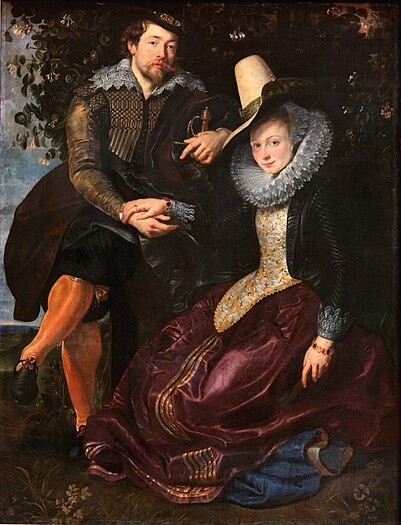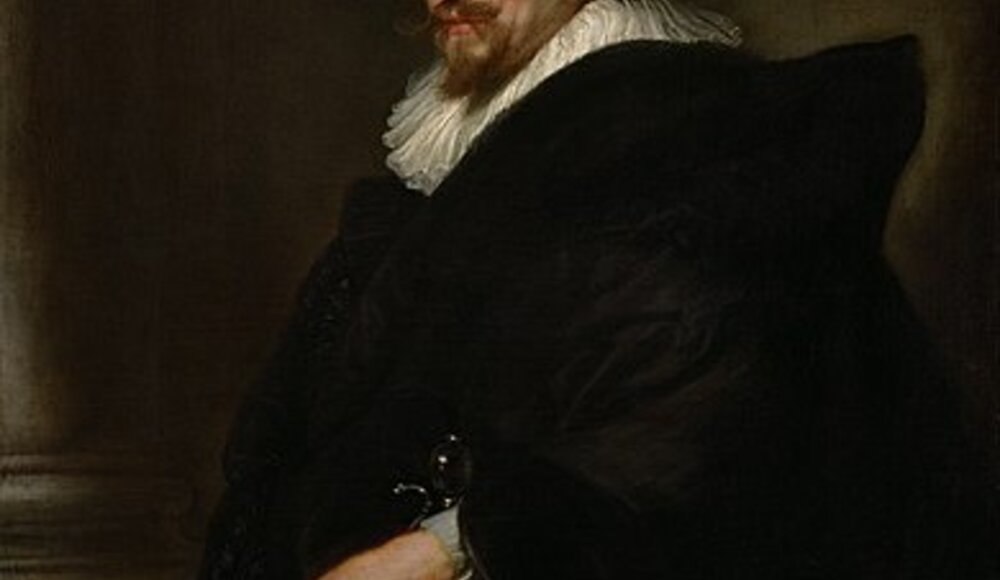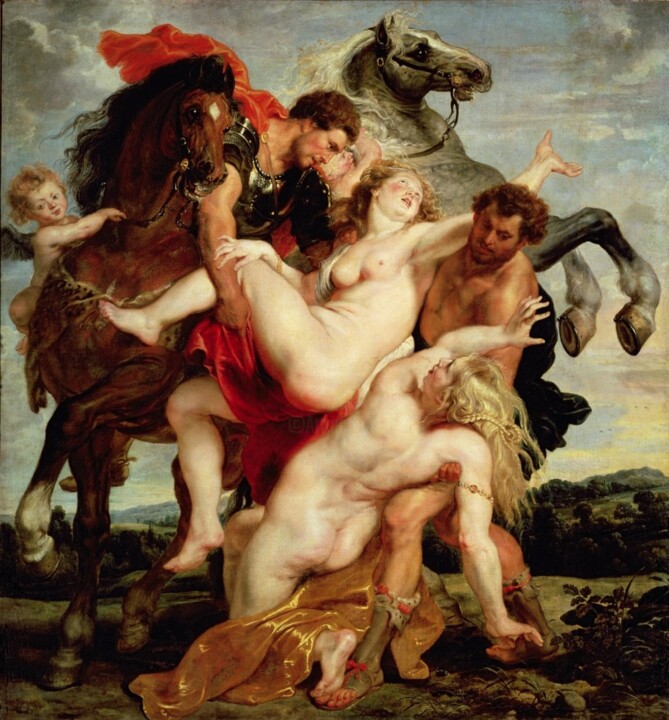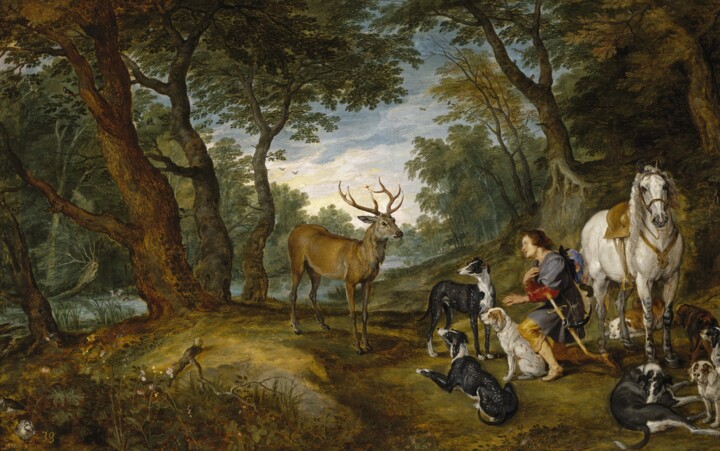 Pieter Paul Rubens, Self-Portrait, 1638 - 1639. Olio su tavola, 109,5×85 cm. Vienna: Kunsthistorisches Museum.
Pieter Paul Rubens, Self-Portrait, 1638 - 1639. Olio su tavola, 109,5×85 cm. Vienna: Kunsthistorisches Museum.
Who was Peter Paul Rubens?
Peter Paul Rubens (1577-1640) was a Flemish Baroque painter, draughtsman, and diplomat. He is considered one of the most important artists of his time and one of the most influential in European art history. Rubens was born in Siegen, Germany, but grew up in Antwerp, Belgium, where he began his artistic training. He traveled to Italy in 1600 and spent eight years there studying the works of the Italian masters and painting commissions for various patrons. He returned to Antwerp in 1608 and became the court painter for the Archduke Albert and the Infanta Isabella, rulers of the Spanish Netherlands. Rubens' paintings are characterized by their dynamic compositions, dramatic use of light and shadow, and sensual depictions of the human figure. He was particularly skilled at depicting movement and emotion, and his works often feature themes from classical mythology and Christian religion. Rubens was also a diplomat and worked on various political missions throughout his career. He was knighted by both Philip IV of Spain and Charles I of England, and his diplomatic skills were highly valued by both rulers. Rubens' legacy can be seen in the work of many later artists, particularly in the Baroque and Rococo periods. He had a profound influence on the development of Flemish art, and his impact on the wider art world has been significant.
 Pieter Paul Rubens, Three Graces, c. 1638. Oil on canvas, 221×181 cm. Madrid: Museo del Prado.
Pieter Paul Rubens, Three Graces, c. 1638. Oil on canvas, 221×181 cm. Madrid: Museo del Prado.
5 key concepts
- Baroque art: Rubens was a prominent figure of the Baroque art movement, which originated in Rome in the early 17th century and spread throughout Europe. Baroque art is characterized by its grandeur, drama, and emotional intensity, as well as its use of ornate decoration and dramatic lighting.
- Human anatomy: Rubens was a skilled painter of the human form and was known for his depictions of muscular, athletic figures. He studied human anatomy in detail and incorporated his knowledge of anatomy into his paintings, giving his figures a sense of realism and vitality.
- Mythology and allegory: Rubens often depicted scenes from classical mythology and incorporated allegorical themes into his work. He used these themes to convey complex ideas and emotions, often through the use of symbols and metaphors.
- Flemish painting: Rubens was part of a rich tradition of Flemish painting, which was known for its realism, attention to detail, and use of rich colors. He was also influenced by Italian Renaissance art, which he studied during his travels to Italy.
- Diplomacy and politics: In addition to his artistic pursuits, Rubens was also involved in diplomacy and politics. He served as a diplomat for the Spanish Netherlands and was involved in negotiations with England and France. He also used his art as a tool of diplomacy, creating portraits of monarchs and other important figures to help secure alliances and diplomatic agreements.
 Pieter Paul Rubens, Rape of the Leucippides, 1615-1618. Oil on canvas, 224×211 cm. Munich: Alte Pinakothek.
Pieter Paul Rubens, Rape of the Leucippides, 1615-1618. Oil on canvas, 224×211 cm. Munich: Alte Pinakothek.
Early life
Jan Rubens and Maria Pypelincks brought Rubens into the world in Siegen. His Calvinist father and Protestant mother left Antwerp for Cologne in 1568, when the Duke of Alba was in charge of the Habsburg Netherlands. At the time, there was a lot of religious conflict and Protestants were being persecuted. Rubens was baptized at St. Peter's Church in the city of Cologne. Jan Rubens became the law adviser and lover of William I of Orange's second wife, Anna of Saxony. He moved to her court in Siegen in 1570 and fathered her daughter Christine, who was born the next year. Jan Rubens was put in jail because of the affair, and Peter Paul Rubens was born the next year, in 1577. The next year, the family moved back to Cologne. Rubens moved to Antwerp with his mother Maria Pypelincks in 1589, two years after his father died. He was raised as a Catholic there.
Apprenticeship
As a child, Rubens received a humanistic education, studying Latin and classical literature. He also received artistic training from Tobias Verhaecht, Adam van Noort, and Otto van Veen. At the age of 14, he was apprenticed to the leading Antwerp painter, Otto van Veen, who introduced him to the art of the Italian Renaissance.
 Pieter Paul Rubens, Consequences of War, 1637-1638. Oil on canvas, 206×345 cm. Florence: Palatine Gallery.
Pieter Paul Rubens, Consequences of War, 1637-1638. Oil on canvas, 206×345 cm. Florence: Palatine Gallery.
Italy (1600-1608)
Pieter Paul Rubensn spent eight years of his early career in Italy from 1600 to 1608. His time in Italy had a profound impact on his artistic style and subject matter, and he created some of his most famous works during this period. Rubens arrived in Italy at the age of 23 and spent the first four years in Venice, where he was influenced by the works of Titian and Veronese. He learned the technique of painting with oils and was captivated by the vibrant colors and dynamic compositions of Venetian art. He also studied the works of Renaissance masters such as Raphael and Michelangelo, which had a lasting impact on his artistic style. In 1601, Rubens traveled to Rome, where he immersed himself in the city's rich artistic history. He studied the works of Caravaggio and other Baroque artists. Rubens' time in Italy had a profound impact on his artistic style and subject matter. He combined the vibrant colors and dynamic compositions of Venetian art with the emotional intensity and dramatic lighting of Caravaggio and other Baroque artists. His works from this period reflect his interest in mythology, religion, and history, and his ability to create complex and dynamic compositions.
 Pieter Paul Rubens, Self-portrait with his wife Isabella Brant, 1609-1610. Oil on canvas, 174×143 cm. Munich: Alte Pinakothek.
Pieter Paul Rubens, Self-portrait with his wife Isabella Brant, 1609-1610. Oil on canvas, 174×143 cm. Munich: Alte Pinakothek.
Antwerp
In 1609, Rubens returned to Antwerp after spending eight years in Italy, where he had studied the works of Renaissance masters such as Michelangelo and Raphael. He quickly became a sought-after artist and was appointed court painter to Archduke Albert and Archduchess Isabella, rulers of the Southern Netherlands. Rubens' paintings from this period are characterized by their dynamic composition, rich colors, and dramatic lighting. He often depicted mythological and religious subjects, and his works were renowned for their sensual beauty and emotional intensity. One of Rubens' most famous works from this period is the "Raising of the Cross," a triptych altarpiece that depicts the crucifixion of Christ. It was commissioned commissioned by the church authorities of the Church of St. Walburga. Cornelis van der Geest, a rich merchant and the churchwarden of the Catholic Church of St. Walburga, got Rubens this job and paid for most of it. Rubens' time in Antwerp was a period of great creativity and productivity. He ran a large workshop, employing numerous assistants and producing a large volume of work, including paintings, tapestries, and prints. Overall, Rubens' time in Antwerp was a crucial period in his career, during which he established himself as one of the leading artists of his era and produced some of his most iconic works.
 Pieter Paul Rubens, The Medusa, c. 1618. Oil on panel, 68×119 cm. Vienna: Kunsthistorisches.
Pieter Paul Rubens, The Medusa, c. 1618. Oil on panel, 68×119 cm. Vienna: Kunsthistorisches.
Death
Rubens died on May 30, 1640, because his long-term gout made his heart fail. He was buried in Antwerp's Saint James' Church. In the church, a chapel was built for the artist and his family to be buried. The chapel was built between 1642 and 1650. The altarstone was brought by Cornelis van Mildert, who was the son of Rubens' friend, the sculptor Johannes van Mildert. The chapel has a marble altar porch with two columns that surround a painting by Rubens of the Virgin Mary, Christ Child, and saints. The Virgin and saints in the picture show how the main ideas of the Counter Reformation were shown. In the upper niche of the retable is a marble figure of the Virgin as the Mater Dolorosa with a sword through her heart. This statue was likely made by Lucas Faydherbe, one of Rubens's students. Later, Helena Fourment, Rubens's second wife, and two of her children, one of whom he fathered, were also buried in the church. Over the next few hundred years, about 80 Rubens family members were buried in the church. Rubens's epitaph, written in Latin by his friend Gaspar Gevartius, was carved into the church floor at the request of canon van Parijs. In the tombstone, Rubens is compared to Apelles, who was the most famous painter in ancient Greece. This is done in the style of the Renaissance.
What are Peter Paul Rubens' most famous paintings?
 Pieter Paul Rubens, Triptych of the Deposition from the Cross, 1611-1614. Oil on panel, 420×150 cm. Antwerp: Cathedral of Our Lady.
Pieter Paul Rubens, Triptych of the Deposition from the Cross, 1611-1614. Oil on panel, 420×150 cm. Antwerp: Cathedral of Our Lady.
- "The Descent from the Cross" (1612-1614): This is perhaps Rubens' most well-known painting, depicting the moment when Christ's body is removed from the cross after his crucifixion.
 Pieter Paul Rubens, The Massacre of the Innocents, 1610. Oil on canvas, 142 cm × 183 cm × 1.9 cm. Toronto: Art Gallery of Ontario.
Pieter Paul Rubens, The Massacre of the Innocents, 1610. Oil on canvas, 142 cm × 183 cm × 1.9 cm. Toronto: Art Gallery of Ontario.
- "The Massacre of the Innocents" (1611 & 1636): This large-scale paintings shows the biblical story of King Herod's order to kill all male infants in Bethlehem to eliminate the threat of the prophesied Messiah.
 Pieter Paul Rubens, The Elevation of the Cross, 1610-11. Oil on wood, 462 cm × 341 cm. Antwerp: Cathedral of Our Lady.
Pieter Paul Rubens, The Elevation of the Cross, 1610-11. Oil on wood, 462 cm × 341 cm. Antwerp: Cathedral of Our Lady.
- "The Elevation of the Cross" (1610-1611): Another religious work, this painting shows the moment when Christ is raised onto the cross. It is notable for its dynamic composition and dramatic lighting.
 Pieter Paul Rubens, The Judgement of Paris, 1636. 144.8 cm × 193.7 cm. London: National Gallery.
Pieter Paul Rubens, The Judgement of Paris, 1636. 144.8 cm × 193.7 cm. London: National Gallery.
- "The Judgment of Paris" (1636 & 1638): This mythological paintings depicts the story of Paris, who was tasked with judging which of three goddesses was the most beautiful.
 Pieter Paul Rubens, The Garden of Love, 1630-1631.
Pieter Paul Rubens, The Garden of Love, 1630-1631.
- "The Garden of Love" (c. 1633): This allegorical painting shows a group of people in a lush garden, engaging in amorous activities. It is known for its sensuality and vibrant colors.
Focus on The Judgment of Paris
The most well-known versions or The Judgement of Paris are the big ones of 1636 in London and 1639 in Madrid. The gods Aphrodite, Athena, and Hera on one side and Paris and Hermes on the other show Rubens' idea of what a beautiful woman should look like. In the 1636 version, Cupid is on the far left and Alecto is above the gods. In the 1639 version, Cupid is between Hera (on the far right) and Aphrodite (in the middle). The 1636 version The story is told the same way in this form as it is in Lucian's "Judgement of the Goddesses." It shows the goddesses getting the golden apple, but changes show that Rubens first painted a different part of the story, when Mercury tells the goddesses to take off their clothes. It was bought in 1844 for London's National Gallery. The masterpiece of 1638 c. was painted in 1638 or 1639 and is now in the Prado. It was finished right before Rubens died, when he was sick with gout. It was ordered by Philip IV of Spain's brother, Cardinal-Infante Ferdinand of Austria. When Ferdinand died, the painting went into the collection of the Spanish royal family. In 1788, King Charles III of Spain thought it was rude and told his people to burn it, but he died before that could happen.
Focus on The Garden of Love
On the left, a couple in love hints at a dance step while a cupid hugs the woman from below. To the right, another couple is sitting on the grass. Some noblewomen talk and do nothing in the middle, enjoying the day and the courtiers' benefits. One of them comes down the stairs to the right at the same time. Behind the group in the center, another group of people are having fun in the shade of the ruins. Above them, inside a small temple, there is a third group. Some of the cupids flying around Juno shoot love darts and bring rose garlands, while others try to get the guests to play love games. With its telamons, columns, and tympanum at the top, classical building looks like a small temple. A scenery goes on past the balustrade and into the distance to the left. Peter Paul Rubens's painting "The Garden of Love" was copied many times by French artists in the 18th century. The picture is about married love and takes place in a yard that looks a lot like the one at the artist's house in Antwerp. A statue of the goddess Juno can be found in a pond. Two jets of water shoot out of her breasts and into the bowl below. The goddess, who represents marriage, is surrounded by cupids flying around and over her and her guests in her yard. Some historians think that all of the faces of the women look like Rubens' second wife, Helena Fourment. His first wife, Isabella Brandt, is the subject of another famous painting.
Focus on The Massacre of the Innocents
The Massacre of the Innocents is the name of two works by Peter Paul Rubens that show the story from the Bible about how innocent people were killed in Bethlehem. The story is told in the Gospel of Matthew. Rubens made the first one between 1611 and 1612. In the 1600s, the work was in the collection of the Liechtenstein Museum in Vienna, Austria, along with Samson and Delilah, another classic by Rubens. In 1767, the painter Vincenzio Fanti left Rubens' work out of his catalog for the Liechtenstein Museum. After that, the Flemish painter Jan van den Hoecke, who worked with Rubens, was given credit for it. The picture stayed at the museum until 1920, when it was bought by an Austrian family. Then, in 1923, it was lent to the Augustinian church Stift Reichersberg in northern Austria. In 2001, George Gordon, an expert on Flemish and German paintings, saw the picture at a sale at Sotheby's in London. Before, it was only thought to be the work of one of Rubens's students, but this expert was sure that it was the work of the master himself because of how similar it was to his other works. And of his style with Samson and Delilah, a picture by Rubens from the same time. The work was sold at a Sotheby's sale on July 10, 2002, to Canadian businessman and art collector Kenneth Thomson for £49.5 million, which is about €62.5 million. At the time, it was the oldest picture that had ever been sold at auction for the most money. After the painting was sold, it was on loan to the National Gallery for a while. In 2008, Kenneth Thomson gave the picture to the Art Gallery of Ontario in Toronto. Behind the group in the center, another group of people are having fun in the shade of the ruins. Above them, inside a small temple, there is a third group. Some of the cupids flying around Juno shoot love darts and bring rose garlands, while others try to get the guests to play love games. With its telamons, columns, and tympanum at the top, classical building looks like a small temple. A scenery goes on past the balustrade and into the distance to the left. A scenery goes on past the balustrade and into the distance to the left. Peter Paul Rubens's painting "The Garden of Love" was copied many times by French artists in the 18th century. The picture is about married love and takes place in a yard that looks a lot like the one at the artist's house in Antwerp. A statue of the goddess Juno can be found in a pond. Two jets of water shoot out of her breasts and into the bowl below. The goddess, who represents marriage, is surrounded by cupids flying around and over her and her guests in her yard. Some historians think that all of the faces of the women look like Rubens' second wife, Helena Fourment. His first wife, Isabella Brandt, is the subject of another famous painting.
 Pieter Paul Rubens, Samson and Delilah, c. 1609. Oil on panel, 185×205 cm. London: National Gallery.
Pieter Paul Rubens, Samson and Delilah, c. 1609. Oil on panel, 185×205 cm. London: National Gallery.
Stylistic characteristics
- Dramatic movement: Rubens was known for his ability to create a sense of movement and energy in his paintings, often through dramatic gestures and dynamic compositions.
- Use of color: Rubens was famous for his use of vivid, intense colors, which he used to create a sense of drama and emotional intensity in his work.
- Bold brushwork: Rubens was not afraid to use bold, sweeping brushstrokes to create texture and convey a sense of movement and energy.
- Contrasting light and shadow: Rubens often used strong contrasts between light and shadow to create depth and drama in his paintings.
- Attention to detail: Despite his use of bold brushwork, Rubens was also known for his attention to detail, particularly in his depictions of human anatomy.
- Large-scale compositions: Rubens was famous for his large-scale paintings, which often featured multiple figures in complex, narrative scenes.
- Romanticism: Rubens was a key figure in the development of the Baroque style, which emphasized emotional expression and drama over classical restraint.
- Sensuality: Rubens was also known for his depictions of the female form, which were often characterized by a sense of sensuality and eroticism.
- Religious themes: Although he also painted secular subjects, Rubens was most famous for his religious paintings, which often featured dramatic scenes from the Bible.
- Fusion of styles: Rubens was influenced by a wide range of artistic traditions, including the Italian Renaissance, the classical world, and the Flemish painting tradition, and his work often reflects a fusion of these styles.
Famous quotes by Rubens
“I’m just a simple man standing alone with my old brushes, asking God for inspiration.“
“Every child has a spirit of creation. The rubbish of life often exterminates the spirit through plague and a soul’s own wretchedness”
“My passion comes from the heavens, not from earthly reflections.”
“White is poison to a picture: use it only in highlights.”


 Selena Mattei
Selena Mattei





